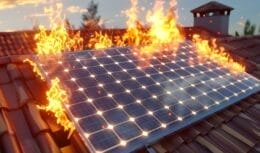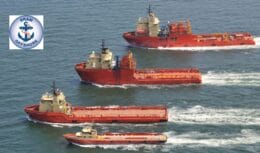
US company announces prototype of a wind energy pyramid. The final version of the offshore wind pyramid could be up to 120 meters high.
Wind energy has the capacity to transform kinetic energy from movement into electrical energy much more cheaply and without generating greenhouse gases in the atmosphere. Now, another pyramid-shaped offshore wind turbine project has come to fruition. This is the prototype of the T-Omega Wind, which promises to be more economical than the options available on the current market.
New offshore wind pyramid structure floats in the sea
The wind energy pyramid was launched and successfully tested in New Bedford, a city in Massachusetts, in the United States. The new offshore wind pyramid has a structure that eliminates the large central pole of offshore wind turbines common in land-based units.
Additionally, it replaces the massive wind vane generators with a double-sided shaft supported at the ends. Therefore, instead of a single tower, the turbine has four diagonal supports forming a floating pyramid. The pyramid is anchored to the seabed, allowing the equipment to float according to the wind, improving wind efficiency.
The prototype of the offshore wind pyramid is 8 m high and the final version will be around 120 meters. T-Omega estimates that the total weight of the wind energy pyramid system varies between 1.200 and 1.800 tons. First, the company tested the structure in a wave tank with a 1/60 scale model.
The test proved that the offshore wind pyramid design was capable of remaining upright even if a full-size version was hit by 30-foot waves. Now, the company responsible for the wind energy pyramid project is testing a 1/16 scale prototype.
Wind energy pyramid project should solve major problems in the sector
The characteristics of T-Omega's new wind turbine structure allows to reduce weight and production costs, in addition to facing logistical challenges in production, implementation and maintenance. Finally, it eliminates the need for specialized installations and can be easily towed in the event of a defect. The expectation is that it will deliver a Levelized Cost of Energy (LCoE) of around US$50 per megawatt-hour with the equipment, which is on par with the best fixed-bottom offshore wind technologies currently available.
The CEO of T-Omega Wind, Brita Formato, told New Atlas that the offshore wind pyramid project should solve major problems in the sector. The offshore wind industry is experiencing challenges.
The new floating wind energy pyramid will solve many of the challenges in an elegant and cost-effective way. The company is excited to introduce this technology to the world's largest offshore wind developers and plans full-scale deployments in the coming years.
Other offshore turbine designs are emerging around the world
The installation of wind turbines on the high seas has emerged as a promising business, considering that it takes advantage of the natural wind coming from the seas, saving space that would be used on land and possible damage to the environment.
Therefore, in addition to the wind energy pyramid, a new single blade wind turbine appears promising to be the great solution, costing half the price to generate even more energy than conventional models.
This is single blade wind turbine from the Dutch company Touchwind. Despite having just one blade, whereas the best-known ones have three, and not having sophisticated systems, the project can cost half the price of a normal installation, and still have more power.












